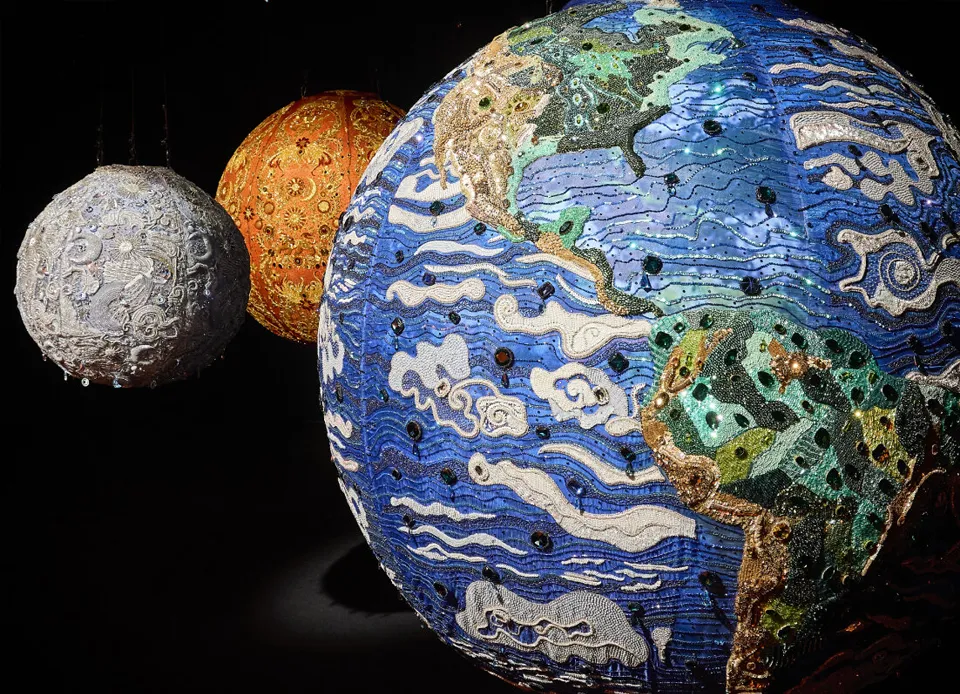The Jewel System by Pakistani artist Sara Shakeel debuted in April 2025 at ArtisTree, a cultural venue powered by Swire Properties, as part of Hong Kong Arts Month. The installation marks a new frontier in digital-meets-traditional artistry, merging AI-generated visuals with handcrafted South Asian embroidery to create an immersive, sparkling experience grounded in both innovation and heritage.

What Is The Jewel System?
At its core, The Jewel System is a celestial-themed installation that explores how machine learning and traditional craft can coexist—and even enhance one another. Shakeel, known globally for her glittery visual language and conceptual storytelling, used AI tools to generate cosmic patterns and constellations. These outputs were then brought to life by hand-embroidering them onto fabric using techniques drawn from South Asian textile traditions.
The final presentation surrounds visitors with shimmering tapestries and illuminated surfaces, offering an encounter that is both digitally inspired and physically intimate.
Why The Jewel System Captured Public Attention
The exhibition quickly drew praise for its unexpected synergy between artificial intelligence and human touch. During the opening week, designboom hosted a well-received panel titled “Embodying the Digital: Translating AI and Digital Art into Physical Forms.” The event featured Shakeel and digital creatives exploring how technology can enrich, rather than replace, human craftsmanship.
The glittering visuals and futuristic themes, juxtaposed with traditional techniques, made the work especially resonant in a city like Hong Kong—where high tech and ancient heritage often live side by side.
Features That Set The Jewel System Apart
The Jewel System is not just visually arresting—it’s conceptually layered. Key features include:
- AI-generated cosmic motifs, designed through text-to-image tools
- Handcrafted embroidery done by skilled artisans based on the AI visuals
- High-contrast design that pairs digital coldness with tactile warmth
- A symbolic fusion of machine precision and cultural memory
- Site-specific immersion tailored to ArtisTree’s modern gallery space
This isn’t AI replacing the artist. It’s AI working in tandem with centuries of textile knowledge.
How Artists and Cultural Institutions Can Learn From It
Shakeel’s installation offers a compelling model for interdisciplinary art. It shows that:
- Artists can use AI as a design assistant without losing personal expression
- Craft practitioners can expand their storytelling tools through digital inspiration
- Museums and venues can curate exhibitions that elevate both technology and tradition
The result is a collaborative practice where algorithms generate form, and human hands give it life.
The Broader Impact: Craft, Code, and Culture
The Jewel System challenges outdated narratives about digital art being cold or impersonal. By anchoring her AI practice in embroidery—a labor-intensive, deeply cultural medium—Shakeel invites a new dialogue: What happens when high-tech tools respect, honor, and amplify cultural heritage?
In this way, the project is not only aesthetic but philosophical. It expands the role of AI in public art from novelty to co-creator in cultural preservation.
What It Means for the Future of AI in Art
As AI becomes increasingly embedded in creative workflows, The Jewel System points toward a future where digital and traditional practices converge. Rather than choosing between craft and code, artists like Shakeel are showing us how to combine them—elevating both.
For curators, collectors, and cultural institutions, this project sets a new benchmark for hybrid art forms that are immersive, collaborative, and emotionally rich.
Learn More
- Visit the artist’s site: Sara Shakeel
- Read the full panel recap on designboom
- Related reading: Refik Anadol’s AI Architecture at Guggenheim Bilbao
Final Thoughts
The Jewel System by Sara Shakeel is more than an exhibition—it’s a statement. It proves that when technology is placed in the service of heritage, the result can be breathtaking. AI, in this context, becomes not a replacement for human creativity—but a tool for expanding it.
